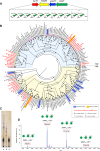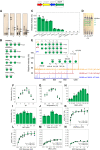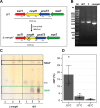Self-recycling and partially conservative replication of mycobacterial methylmannose polysaccharides
- PMID: 36707645
- PMCID: PMC9883506
- DOI: 10.1038/s42003-023-04448-3
Self-recycling and partially conservative replication of mycobacterial methylmannose polysaccharides
Abstract
The steep increase in nontuberculous mycobacteria (NTM) infections makes understanding their unique physiology an urgent health priority. NTM synthesize two polysaccharides proposed to modulate fatty acid metabolism: the ubiquitous 6-O-methylglucose lipopolysaccharide, and the 3-O-methylmannose polysaccharide (MMP) so far detected in rapidly growing mycobacteria. The recent identification of a unique MMP methyltransferase implicated the adjacent genes in MMP biosynthesis. We report a wide distribution of this gene cluster in NTM, including slowly growing mycobacteria such as Mycobacterium avium, which we reveal to produce MMP. Using a combination of MMP purification and chemoenzymatic syntheses of intermediates, we identified the biosynthetic mechanism of MMP, relying on two enzymes that we characterized biochemically and structurally: a previously undescribed α-endomannosidase that hydrolyses MMP into defined-sized mannoligosaccharides that prime the elongation of new daughter MMP chains by a rare α-(1→4)-mannosyltransferase. Therefore, MMP biogenesis occurs through a partially conservative replication mechanism, whose disruption affected mycobacterial growth rate at low temperature.
© 2023. The Author(s).
Conflict of interest statement
The authors declare no competing interests.
Figures







Similar articles
-
Biosynthesis of mycobacterial methylmannose polysaccharides requires a unique 1-O-methyltransferase specific for 3-O-methylated mannosides.Proc Natl Acad Sci U S A. 2019 Jan 15;116(3):835-844. doi: 10.1073/pnas.1813450116. Epub 2019 Jan 3. Proc Natl Acad Sci U S A. 2019. PMID: 30606802 Free PMC article.
-
Biosynthesis of the mycobacterial methylmannose polysaccharide. Identification of a 3-O-methyltransferase.J Biol Chem. 1984 Mar 25;259(6):3464-9. J Biol Chem. 1984. PMID: 6706967
-
Revisiting the specificity of an α-(1→4)-mannosyltransferase involved in mycobacterial methylmannose polysaccharide biosynthesis.Chembiochem. 2012 May 29;13(8):1139-51. doi: 10.1002/cbic.201200121. Epub 2012 Apr 19. Chembiochem. 2012. PMID: 22619150
-
Polymethylated polysaccharides from Mycobacterium species revisited.J Biol Chem. 2009 Jan 23;284(4):1949-53. doi: 10.1074/jbc.R800047200. Epub 2008 Sep 11. J Biol Chem. 2009. PMID: 18786916 Free PMC article. Review.
-
Treatment of slowly growing mycobacteria.Clin Chest Med. 2015 Mar;36(1):79-90. doi: 10.1016/j.ccm.2014.10.005. Epub 2014 Nov 6. Clin Chest Med. 2015. PMID: 25676521 Review.
References
-
- Falkinham JO., III Current epidemiologic trends of the nontuberculous mycobacteria (NTM) Curr. Environ. Health Rep. 2016;3:161–167. - PubMed
-
- Nunes-Costa D, Alarico S, Dalcolmo MP, Correia-Neves M, Empadinhas N. The looming tide of nontuberculous mycobacterial infections in Portugal and Brazil. Tuberculosis. 2016;96:107–119. - PubMed
-
- Holt MR, Kasperbauer S. Management of extrapulmonary nontuberculous mycobacterial infections. Semin. Respir. Crit. Care Med. 2018;39:399–410. - PubMed
Publication types
MeSH terms
Substances
LinkOut - more resources
Full Text Sources
Molecular Biology Databases
Research Materials

